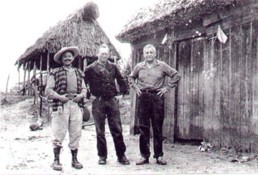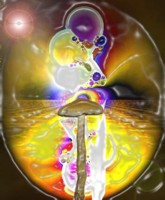Mushroom Pioneers
Chapter 3. Rolf Singer and the Misidentification of Teonanácatl
Both Schultes' and Schultes & Reko's original 1938 collections of Oaxacan fungi were forwarded from México to the Farlow Herbarium at Harvard University. They represented probably three different species (Panaeolus campanulatus var. sphinctrinus, Psilocybe cubensis identified by Singer and Psilocybe caerulescens by recorded name). These collections were accidentally placed on a single herbarium sheet and were later separated in 1941 by mycologist Rolf Singer. In 1958, mycologists Rolf Singer and Alexander H. Smith conducted follow-up research on the previous studies by Schultes and Reko, Wasson and Heim. Singer (1958), used Heim's papers and illustrations from Wasson's Life article as a guide list and) described the labels for both collections of Schultes and Reko's fungi collections but was confused by Schultes' written description of a species that Singer believed was Panaeolus sphinctrinus. Interestingly enough, Schultes' macroscopic description of this species actually fit the description of Psilocybe mexicana Heim. The first label on this herbarium sheet read as follows:
 |
Fig 3. Schultes in his office Harvard, late 1980's |
It appears that Schultes may have collected two different species of mushrooms in the springy meadows. One variety being Panaeolus campanulatus var. sphinctrinus and the other being Psilocybe mexicana. Singer (1958) had noted that "Springy meadows was the known habitat for Psilocybe mexicana and cuspidate is a characteristic feature of the genus Psilocybe, as are the brown gills which were mentioned and the coffee brown color of the mushroom." However, the black gills reported by Schultes would definitely fit the description of a Panaeolus species. Schultes had not reported that his collection occurred in manure or from the ground. If they were coprophilous Schultes would have mentioned it. Furthermore, she-to and to-ska are epithets used by the Mazatec and Chinantec to describe Psilocybe mexicana (see Allen, 1997b). The author also found the epithets to-shka and shi-to being used to identify a species of Panaeolus.
The second collection deposited by Schultes and Reko had originally been misidentified by Singer as Stropharia (Psilocybe) caerulescens. The paper on this second sheet read as follows:
"Plantae Utiles Mexicana, Oaxaca. Common Name (Mexican) nanacate. Tribe: Mazatec. Indian name: kee-sho. Habitat freshets during the rainy season. Locality: Huautla. Uses: from four to eight are eaten to produce a temporary narcotic state of hilarity. Said to be poisonous if taken in excess, causing permanent insanity" (Singer & Smith, 1958).
Singer mistakenly noted these mushrooms to be Stropharia caerulescens [syn.=Psilocybe cubensis (Earle) Singer]. Later Singer realized that he had misidentified this species when he learned that the word kee-sho referred to the Mazatec Indian landslide mushroom later identified as Psilocybe caerulescens var. mazatecorum. Ott (1993), in a personal communication to the author, believed these mushrooms to be Psilocybe caerulescens Murr., a mushroom known to occur in sugar cane mulch and at roadside landslides, yet the habitat for this collection was listed as freshets, which as one may surmise, are the dung of cattle. Thus it appears that this second collection was probably Psilocybe cubensis (Earle) Singer. Interestingly, in 1923, Psilocybe caerulescens Murr. was originally discovered and identified in Huntsville, Alabama, yet it has never been reported from Alabama since. However, this species has since been reported from Florida (Jacobs, 1975).
Singer (1958) noted that Santesson (1939), was probably the first author to publish data on both pharmacological research and chemical analyses of fungi believed to be the cause of what is known as cerebral mycetismus or psychotropic mushroom poison.
Santesson conducted laboratory experiments with extracts of various mushrooms using animal subjects in his investigations. However, it should be noted that it was actually Dr. Michael Levine who in 1917 attempted to investigate the suspected effects of Panaeolus venenosus (=syn. Panaeolus subbalteatus, a fungus known to cause cerebral mycetismus in humans), yet Dr. Levine did not attempt to isolate the suspected ingredients of the mushrooms during his course of research.
One of the mushrooms allegedly used in Santesson's experiments was Armellariella mellea (the honey mushroom). Singer wrote that he was in doubt as to Santesson's identification and asserted that the mushroom in question may have been either Psilocybe mexicana or Psilocybe cubensis, or possibly a mixture of both.
It should be mentioned that the above noted observation on Santesson's alleged identification of the "honey-mushroom" is based on the writings of Schultes who mentioned that Santesson had used the word Hallimahl, which Schultes identified as Hallimasch, a European name for the "honey-mushroom." Ott (1993b) states that Schultes was in error in his identification of this species (see Ott, 1993a: footnote 6, page 298). Recently Guzmán-Dávalos and Guzmán (1991) identified Gymnopilus subpurpuratus from Mexico as "staining green when handled." A related variety is Gymnopilus purpuratus Cooke & Masse, a species which has been identified as psilocybian. Both of these species macroscopically resemble the honey mushroom, so there is a possibility that Santesson may in fact have had a real hallucinogenic specimen after all.
 |
Fig. 4. Rolf Singer's assistant Palácios, Singer & Gordon
Near Huautla (July 1957) |
Schultes (1978) later wrote that "Wasson and Heim, and Singer and Guzmán [all] failed to find Panaeolus campanulatus var. sprinctrinus in use and, as a result, have assumed that it should not be included in the list of hallucinogenically used Mexican mushrooms." The late French mycologist Roger Heim (1963), also asserted that "the Indians do not take Panaeolus campanulatus var. sprinctrinus in their rituals", and Singer (1958) after one short field trip, categorically stated that "Panaeolus campanulatus var. sprinctrinus is not used and perhaps, had been mistaken for Psilocybe mexicana Heim." The noted Mexican authority on the sacred mushrooms of Mexico, Gastón Guzmán (1977), called Panaeolus campanulatus var. sprinctrinus a "false teonanácatl" while P. Antoine (1970) claimed that this belief has spread and still exists. However, eight years later, Singer (1978) still believed that no species of Panaeolus belongs to the group of Mexican hallucinogenic mushrooms which were known as teonanácatl. In 1979, Schultes wrote that "certain shamans and curanderas of the Mazatec and Chinantec Indians do employ the mushroom known as Panaeolus campanulatus var. sprinctrinus in curative and divinatory ceremonies." These Panaeolus species are known to the Indians as tha-na-sa, shi-to and to-shka. They are bell-shaped or ovoid-campanulate shaped in the cap and appear to be yellowish-brown in color. Several of the early Spanish codices noted above that one of the yellow mushrooms described was called teonanácatl. The author also found these latter two epithets used by the Mazatec in describing Psilocybe mexicana.
Specimens of Panaeolus sprinctrinus collected in Mexico by French Canadian mycologist György-Miklos Ola'h (1969) were found to contain psilocine and Ola'h classified this species as `latent' psilocybian.
However, as late as 1983, Guzmán still maintained that "in Mexico, no Panaeolus species is used as a sacred or divine mushroom among the Indians of Oaxaca, and that includes the Mazatec, Chatino, Zapotec, and Mixes, and of the Indians in the State of México, in spite of the fact that the species of Panaeolus are very common." Panaeolus species were collected independently as one of the sacred hallucinogenic mushrooms by two groups of investigators, Weitlaner's group and by Schultes and Reko. Previous chemical analyses of these collections revealed that some species of Panaeolus and even Panaeolus campanulatus var. sprinctrinus do contain the indole chemical psilocybine and psilocine (Ola'h, 1970; Ott, 1976; Tyler & Gröger, 1964). However, one should consider that in a single collection of a particular species, there may be more than two species represented---for example, one species might superficially resemble another, as in the case of Panaeolina foenisecii and Panaeolus subbalteatus, both of which resemble one another macroscopically.
 |
Image 4. Designed by
John W. Allen |


